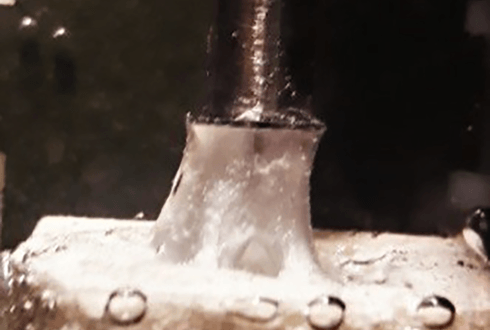Apr 8 2019
From a technical standpoint, underwater adhesion is very difficult owing to the presence of water, which is believed to be the worst enemy for any kind of glue.
 Underwater adhesion test on the bioinspired glue. (Image credit: Marco Dompé and Francisco J. Cedano-Serrano)
Underwater adhesion test on the bioinspired glue. (Image credit: Marco Dompé and Francisco J. Cedano-Serrano)
Now, a research team from Wageningen University & Research has created a novel injectable adhesive that is capable of bonding to a variety of surfaces underwater.
The mechanical properties of an adhesive are considerably weakened by water, thereby preventing an excellent contact with the surface. As a result, the development of injectable adhesives for wet environments, for example, the human body is rather limited. The medical domain, particularly when regarding wound closure and soft tissue repair, would significantly benefit from the development of glues that would help substitute surgeon- and patient-unfriendly techniques like stapling and suturing.
Inspired by nature
Cellotape is an example of pressure-sensitive adhesives that is quite popular. This kind of adhesive can work effectively on nearly any kind of dry surface, but once the surface becomes wet, its performance is considerably undermined. Conversely, this difficulty has been solved much before by a number of natural organisms, like sandcastle worms and mussels. These animals live underwater and are capable of releasing a fluid phase within the water. This substance effectively solidifies owing to a variation in the environmental conditions, such as ionic strength, pH, etc., allowing the organisms to adhere to various kinds of surfaces. Predominantly made up of oppositely charged protein domains, the natural glue is stored in the form of complex coacervate—a fluid and water-immiscible phase. Inspired by these creatures, scientists at the Wageningen Physical Chemistry and Soft Matter group developed an innovative glue that solves a majority of difficulties related to underwater adhesion.
Heat and stick
To prepare the adhesive, aqueous solutions of oppositely charged polymers altered with thermosensitive units are mixed together. The material, which looks like liquid at room temperature, instantly changes into a solid as soon the temperature is increased to more than 32 °C, and that is when the thermoresponsive chains come together and collapse, rendering the adhesive much more robust.
When the material was tested underwater, it demonstrates excellent adhesive characteristics, adhering tightly to a wide range of surfaces like Teflon, glass, or charged surfaces. Hence, the developed glue is the perfect candidate for gluing tissues within the human body, wherein the environmental temperature would activate an instant setting without the need for inserting any more chemical species. Besides that, considering its low viscosity at room temperature, the material can be easily injected and since it is water-immiscible, it does not disperse in the environment.
Currently, the investigators are exploring ways to optimize the properties of the material so as to achieve a more improved performance. This would enable them to test the adhesive characteristics on actual biological tissues.